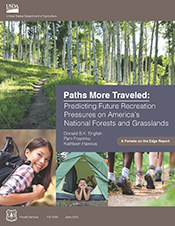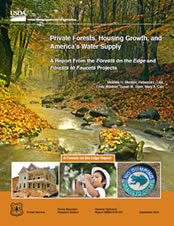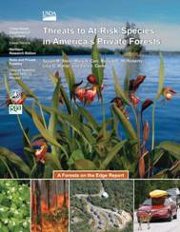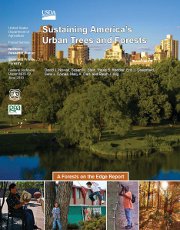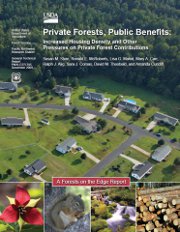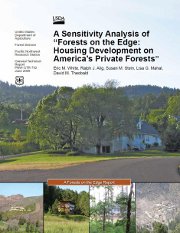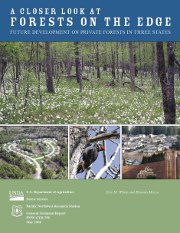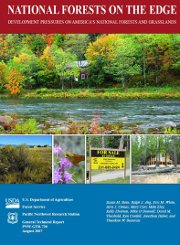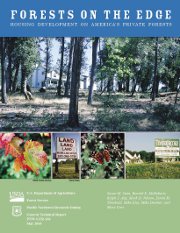You are here: Publications
Publications
Open Space Conservation Publications
| Across the Green Line (2014) | USFS Open Space Conservation Strategy (2007) |
 |
 |
| Open Space Conservation Strategy Brochure (2007) | Cooperating Across Boundaries (2006) |
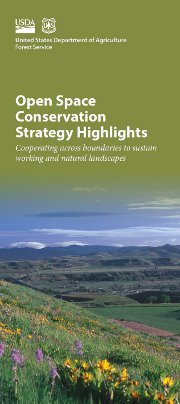 |
 |
Forests on the Edge (FOTE) Publications
Forest Service Research Supporting the Open Space Conservation Strategy
Additional Papers Sponsored by FOTE
- Stein, S.M.; McRoberts, R.E.; Nelson, M.D.; Mahal, L.; Flather, C.H.; Alig, R.J.; Comas, S.J. 2010. Private Forest Habitat for At-Risk Species: Where Is It and Where Might It Be Changing? Journal of Forestry, Volume 108, Number 2 , pp. 61-70(10).
- Lewis, D.J. 2009. An economic framework for forecasting land-use and ecosystem change.
- Lewis, D.J.; Alig, R.J. 2009. Empirical Methods for Modeling Landscape Change, Ecosystem Services, and Biodiversity. Western Economics Forum, A Journal of the Western Agricultural Economics Association. Vol.VIII, No.1, Spring 2009. pg 29- 39
- Stein, S., M. Robles, E. White, and S. Comas. 2009. Forest development across the USA and implications for wildlife. In Proceedings of the 72nd North American Wildlife and Natural Resources Conference. March 20 – 24, 2007, Portland, OR. Pp 241 – 244.
- Robles, Marcos D.; Flather, Curtis H.; Stein, Susan M.; Nelson, Mark D.; Cutko, Andrew 2008. The geography of private forests that support at-risk species in the conterminous United States. Frontiers in Ecology and the Environment. 6(6): 301-307.
- Alig, R. and E. White. 2007. Projections of forestland and developed land areas in western Washington. Western Journal of Forestry. 22(1): 29-35.
- White, E., S. Stein, R. Alig. 2007. National forests on the edge: development pressures on America's National Forest system (pp241-244). In: Laband, D.N., ed. Proceedings, emerging issues along urban-rural interfaces II: linking land-use science and society. Auburn, AL: Auburn University. pp 241-244.
- Stein, S. M.; Hatfield, M. A.; McRoberts, R. E.; Meneguzzo, D. M.; Comas, S. 2006. Threats to Private Forest Lands in the U.S.A.: A Forests on the Edge Study. Paper presented at Advances in Threat Assessment and Their Application to Forest and Rangeland Management Conference, Boulder, CO. Available online at http://www.forestencyclopedia.net/p/p3613.
- Stein, S.; McRoberts, R.E.; Nelson, M.D.; Theobald, D.M.; Eley, M.; Dechter, M. 2006. Forests on the edge: a GIS based approach to projecting housing development on private forests. In: Aguirre-Bravo, C.; Pellicane, Patrick J.; Burns, Denver P.; and Draggan, Sidney, Eds. 2006. Monitoring Science and Technology Symposium: Unifying Knowledge for Sustainability in the Western Hemisphere Proceedings RMRS-P-42CD. Fort Collins, CO: U.S. Department of Agriculture, Forest Service, Rocky Mountain Research Station. p. 736-743.
- Stein, Susan M.; Hatfield, Mark; McRoberts, Ronald E.; Meneguzzo, Dacia M.; Dechter, Mike; Zhou, Xiaoping; Mills, John; Eley, Mike; Liknes, Greg C.; Coulston, John W.; Comas, Sara. 2007. Forests on the edge: evaluating contributions of and threats to America's private forest lands. In: McRoberts, Ronald E.; Reams, Gregory A.; Van Deusen, Paul C.; McWilliams, William H., eds. Proceedings of the seventh annual forest inventory and analysis symposium; October 3-6, 2005; Portland, ME. Gen. Tech. Rep. WO-77. Washington, DC: U.S. Department of Agriculture, Forest Service. pp. 135-142.
Additional Publications to which FOTE has Contributed Data
- Stein, S., M. Carr, R.E. McRoberts, and L.G. Mahal. 2012. Forests on the Edge: The Influence of Increased Housing Density on Forest Systems and Services. Chapter 4 in D.N. Laband, B.G. Lockaby, and W.C. Zipperer. Urban-Rural Interfaces: Linking People and Nature, American Society of Agronomy, Soil Science Society of America, Crop Science Society of America, Madison, Wisconsin. 352 p.
- Alig, R.J.; Stewart, S.; Wear, D.; Stein, S.; Nowak, D. 2010. Conversions of forest lands: trends, determinants, and policy considerations. Vol 1, pp 1 - 25. In: Pye, John M.; Rauscher, H. Michael; Sands, Yasmeen; Lee, Danny C.; Beatty, Jerome S., tech. eds. Advances in threat assessment and their application to forest and rangeland management. Gen. Tech. Rep. PNW GTR-802. Portland, OR: U.S. Department of Agriculture, Forest Service, Pacific Northwest and Southern Research Stations. 708 p. 2 vol.
- White, E.M.; Alig, R.J.; Stein, S.M. 2010. Socioeconomic changes and forestland development: commonalities and distinctions between the eastern and western United States. Journal of Forestry, Volume 108, Number 7, pp. 329-337(9).
- Foster, D., B. Donahue, D. Kittredge, K.F. Lambert, M. Hunter, B. Hall, L.C. Irland, R.J. Lilieholm, D. Orwig, A. D’Amato, E. Colburn, J. Thompson, J. Levitt, A. Ellison, W. Keeton, J. Aber, C. Cogbill, C. Driscoll, and C. Hart. 2010. Wildlands & Woodlands: A Vision for the New England Landscape. Harvard University Press. 50 pages. (In Press)
- Smith, W. Brad, tech. coord.; Miles, Patrick D., data coord.; Perry, Charles H., map coord.; Pugh, Scott A., Data CD coord. 2009. Forest Resources of the United States, 2007. Gen. Tech. Rep. WO-78. Washington, DC: U.S. Department of Agriculture, Forest Service, Washington Office. 336 p. Chapter 3 Forests and People, Forests on the Edge. pp 36 – 40.
- Stein, S.M., R. McRoberts, M.E. Nelson, L.G. Mahal, R. Alig, S. Comas, and C. Flather. 2010. Private Forest Habitat for At-Risk Species - Where is it and where might it be changing? Journal of Forestry, Volume 108, Number 2. pp. 61-70.
Nationally Focused Projections
- Alig, R.J., A.J. Plantinga, D. Haim, and M. Todd. 2010. Area changes in U.S. forests and other major land uses, 1982 to 2002 with projections to 2062. Gen. Tech. Rep. PNW-GTR-815. Portland, OR: Department of Agriculture, Forest Service, Pacific Northwest Research Station. 98 p.
- Alig, R.J., S. Stewart, D. Wear, S. Stein, and D. Nowak. 2010. Conversions of forest lands: trends, determinants, and policy considerations. Vol 1, pp 1 - 25. In: Pye, John M.; Rauscher, H. Michael; Sands, Yasmeen; Lee, Danny C.; Beatty, Jerome S., tech. eds. Advances in threat assessment and their application to forest and rangeland management. Gen. Tech. Rep. PNW GTR-802. Portland, OR: U.S. Department of Agriculture, Forest Service, Pacific Northwest and Southern Research Stations. 708 p. 2 vol.
- Alig, R.J., J.D. Kline, and M. Lichtenstein. 2004. Urbanization on the U.S. landscape: looking ahead in the 21st Century. Landscape and Urban Planning 69(2-3):219-234.
- Cordell, K.H., and C. Overdevest. 2001. Footprints on the Land: An Assessment of Demographic Trends and the Future of Natural Lands in the United States. Sagamore Publishing.
- Haight, R.G., and P.H. Gobster. 2009. Social and Economic Considerations for Planning Wildlife Conservation in Large Landscapes. In Millspaugh, J.J., and Thompson, F.R. (Eds.), Models for Planning Wildlife Conservation in Large Landscapes (pp. 123-152). Burlington, MA: Academic Press.
- Haim D., R. Alig, A. Plantinga, and B. Sohngen, 2011. "Climate Change and Future Land Use in the United States: An Economic Approach". Climate Change Economics, 2(1):27-51.
- Radeloff, V.C., S.I. Stewart, T.J. Hawbaker, U. Gimmi, A.M. Pidgeon, C.H. Flather, R.B. Hammer, and D.P. Helmers. 2010 Housing growth in and near United States protected areas limits their conservation value. PNAS Vol. 107, No. 2: 940-945
- Ritters, K.H. 2011. Spatial patterns of land cover in the United States: a technical document supporting the Forest Service 2010 RPA Assessment. Gen. Tech. Rep. SRS-136. Asheville, NC: Department of Agriculture Forest Service, Southern Research Station. 64 p.
- Riitters, K.H. 2005. Downscaling Indicators of Forest Habitat Structure from National Assessments. Ecological Indicators 5: 273-279.
- Riitters, K.H., J.D. Wickham, R.V. O'Neill, K.B. Jones, E.R. Smith, J.W. Coulston, T.G. Wade, and J.H. Smith. 2002. Fragmentation of Continental United States Forests. Ecosystems 5: 815-822.
- White, E.M., A.T. Morzillo, and R.J. Alig. 2009. Past and projected rural land conversion in the US at state, regional, and national levels. Landscape and Urban Planning 89:37-48.
Projections - Regional Focus
- Block-Torgerson, K., M.A. Kilgore, S.J. Taff, and S.A. Snyder. 2010. Forest Land Parcelization in Northern Minnesota: A Multicounty Assessment. December 2010. University of Minnesota Department of Forest Resources, Staff Paper #212. December 2010. 96 p. (http://www.forestry.umn.edu/Publications/StaffPaperSeries/index.htm)
- Gardner, N., A.B. Sutherland, M.C. Scott, J. L. Meyer, G.S. Helfman, E.F. Benfield, C.M. Pringle, R.F. Bixby, P.V. Bolstad, and D.N. Wear. 2009. Linking Stream and Landscape Trajectories in the Southern Appalachians. Environmental Monitoring and Assessment 156(1-4):17-36. http://www.treesearch.fs.fed.us/pubs/36259
- Gobster, P.H., R.G. Haight, and D. Shriner. 2000. Landscape Change in the Midwest: An Integrated Research and Development Program. Journal of Forestry, 98(3): 9-14.
- Gobster, P.H., R.G. Haight, and D.S. Shriner. 2000. Integrated Research on Midwestern Landscape Change: A Program Description and Progress Report. pp. 375-382 In: DeCoster, L. (ed.) Proceedings: Fragmentation 2000: A Conference on Sustaining Private Forests in the 21st Century, September 17-20, 2000, Annapolis, MD.
- Gobster. P.H., and R.G. Haight. 2004. From Landscapes to Lots: Understanding and Managing Midwestern Landscape Change: A Progress Report. General Technical Report NC-245. St. Paul, MN: USDA Forest Service, North Central Research Station.
- Helmer, E.H. 2004. Forest conservation and land development in Puerto Rico. Landscape Ecology 19: 29-40.
- Helmer, E.H., T. Kennaway, D.H. Pedreros, M.L. Clark, H. Marcano-Vega, L.L. Tieszen, T.R. Ruzycki, S.R. Schill, and C.M.S. Carrington. 2008. Land cover and forest formation distributions for St. Kitts, Nevis, St. Eustatius, Grenada and Barbados from decision tree classification of cloud-cleared satellite imagery. Caribbean Journal of Science, Vol. 44, No. 2, 175-198.
- Helmer, E.H., O. Ramos, T.D.M. López, M. Quiñones, and W. Diaz. 2002. Mapping the forest type and land cover of Puerto Rico, a component of the Caribbean biodiversity hotspot. Caribbean Journal of Science, Vol. 38, No.3-4, 165-183.
- Kline, J.D., A. Moses, D.L. Azuma, and A. Gray. 2009. Evaluating satellite imagery-based land use data for describing forest land development in western Washington. Western Journal of Applied Forestry 24(4):214-222.
- Kline, J.D., A. Moses, G. Lettman, and D.L. Azuma. 2007. Modeling forest and rangeland development in rural locations, with examples from eastern Oregon. Landscape and Urban Planning 80(3):320-332.
- Kline, J.D., D.L. Azuma, and A. Moses. 2003. Modeling the spatially dynamic distribution of humans in the Oregon (USA) Coast Range. Landscape Ecology 18(4):347- 361.
- Mundell, J., Taff, S.J., Kilgore, M.A., and S.A. Snyder. 2007. Assessing Trends in Forest Parcelization and Development in Minnesota: An Itasca County Case Study. A report to the Minnesota Forest Resource Council. UMN Forest Resources Staff Paper Series #192, Department of Forest Resources, University of Minnesota, St. Paul, MN. http://www.forestry.umn.edu/publications/staffpapers/Staffpaper192.pdf)>
- Turner, M.G., S.M. Pearson, P. Bolstad, and D.N. Wear. 2003. Effects of Land-Cover Change (1950-1990) on Spatial Pattern of Forest Communities in the Southern Appalachians. Landscape Ecology 18:449-464. http://www.treesearch.fs.fed.us/pubs/6309
- Turner, M.G., D.N. Wear, and R.O. Flamm. 1996. Landownership and Land Cover Change in the Southern Appalachian Highlands and the Olympic Peninsula. Ecological Applications 6:1150-1172. http://www.treesearch.fs.fed.us/pubs/4462
- Wear, D.N., and P. Bolstad. 1998. Land Use Changes in Southern Appalachian Landscapes: Spatial Analysis and Forecast Evaluation. Ecosystems 1(6):575-594 .http://www.treesearch.fs.fed.us/pubs/763
Factors influencing landscape change and projections
- Gobster, P.H., Stewart, S.I., and D.N. Bengston, Editors. 2004. The Social Aspects of Landscape Change: Protecting Open Space under the Pressure of Development. Special Theme issue of Landscape and Urban Planning 69(2-3): 149-334.
- Gobster, P.H., and Rickenbach, M.G. 2004. Private Forestland Parcelization and Development in Wisconsin's Northwoods: Perceptions of Resource-Oriented Stakeholders. Landscape and Urban Planning 69(2-3): 165-182.
- Hardie, I., P. Parks, P. Gottlieb, and D. Wear. 2000. Responsiveness of Rural and Urban Land Uses to Land Rent Determinants in the South. Land Economics 76(4): 659-673. http://www.treesearch.fs.fed.us/pubs/4449
- Helmer, E. H., T.J. Brandeis, A.E. Lugo, and T. Kennaway. 2008. Factors influencing spatial pattern in tropical forest clearance and stand age: Implications for carbon storage and species diversity, Journal of Geophysical Research, Vol. 113, G02S04, doi:10.1029/2007JG000568.
- Kennaway, T., and E.H. Helmer. 2007. The forest types and ages cleared for land development in Puerto Rico. GIScience & Remote Sensing, 44, No. 4, p. 356–382.
- Mundell, J., Taff, S.J., Kilgore, M.A., and S.A. Snyder. 2010. Using Real Estate Records to Assess Forest Land Parcelization and Development: A Minnesota Case Study. Landscape and Urban Planning. 94, 71-76.
- Parks, P.J., I.W. Hardie, C.A. Tedder, and D.N. Wear. 2000. Using Resource Economics to Anticipate Forest Land Use Change in the U.S. Mid-Atlantic Region. Environmental Monitoring and Assessment 63(1): 175-185. http://www.treesearch.fs.fed.us/pubs/2290
- Rickenbach, M.G., and P.H. Gobster. 2003. Stakeholders' Perceptions of Parcelization in Wisconsin's Northwoods. Journal of Forestry 101(9): 18-23.
- Riitters, K.H., J.D. Wickham, and T.G. Wade. 2009. An indicator of forest dynamics using a shifting landscape mosaic. Ecological Indicators, Vol. 9: 107-117.
- Riitters, K.H., P. Vogt, P. Soille, J. Kozak, and C. Estreguil. 2007. Neutral model analysis of landscape patterns from mathematical morphology. Landscape Ecol., Vol. 22: 1033-1043.
- Vogt, P., K.H. Riitters, C. Estreguil, J. Kozak, T.G. Wade, and J.D. Wickham. 2006. Mapping spatial patterns with morphological image processing. Landscape Ecol., vol. 22: 171-177
- Wagner, M., and P.H. Gobster, (2007). Intersections in Landscape Change Characterization: measured biophysical change and social dynamics. Landscape and Urban Planning 81(1-2): 67-80.
- Wear, D.N., and D.H. Newman. 2004. The speculative shadow over timberland values in the US South. Journal of Forestry (December): 25-31. http://www.treesearch.fs.fed.us/pubs/7730
- Wear, D.N., M.G. Turner, R.O. Flamm. 1996. Ecosystem Management with Multiple Owners: Landscape Dynamics in a Southern Appalachian Watershed. Ecological Applications 6:1173-1188. http://www.treesearch.fs.fed.us/pubs/4465
- Wear, D.N., J. Pye, and K. Riitters. 2004. Targeting conservation with fragmentation forecasts. Ecology and Society 9(5): online URL: (Special issue on Urban Sprawl). http://www.ecologyandsociety.org/vol9/iss5/art4/index.html
- Wickham, J.D., K.H. Riitters, T.G. Wade, and C. Homer. 2008. Temporal change in fragmentation of continental US forests. Landscape Ecology Vol. 23: 892-898.
Protecting priority lands through partnerships, conservation easements,
land exchanges, etc.
- Arthur, J.L., J.D. Camm, R.G. Haight, C.A. Montgomery, and S. Polasky. 2004. Weighing conservation objectives: Maximum expected coverage versus endangered species protection. Ecological Applications 14(6): 1936-1945. http://www.nrs.fs.fed.us/pubs/821
- Bengston, D.N, J.O. Fletcher, and K.C. Nelson. 2004. Public policies for managing urban growth and protecting open space: policy instruments and lessons learned in the United States. Landscape and Urban Planning 69:271-286.
- Fischer, A.P., A. Callahan, J. Koch, T.A. Spies, C.S. Olsen, E.M. White and D. Jacobs In press. Using an agent-based social network model to investigate interactions between social and ecological systems: Early reflections on the Forest, People, Fire project. Practicing Anthropology.
- Wolf, K.L., D.J. Blahna, W. Brinkley, and M. Romolini. 2011. Environmental stewardship footprint research: Linking human agency and ecosystem health in the Puget Sound Region. Urban Ecosystems (DOI 10.1007/s11252-011-0175-6).
Federal taxes or policy modifications
- Butler, B.J., J.H. Hewes, P. Catanzaro, J.L. Greene, M.A. Kilgore, D.B. Kittredge, J. Langer, Z. Ma, A. Reuben, and M. Tyrrell. 2010. Effects of Federal, State, and Local Tax Policies on Family Forest Owners: Technical Report. FFRC Research Paper No. 2010-01. Family Forest Research Center, Amherst, Massachusetts. 76 p. Accessible at: http://www.familyforestresearchcenter.org/projects/taxes.html
- Greene, J.L., T.J. Straka, and R.J. Dee. 2004. Nonindustrial private forest owner use of federal income tax provisions. Forest Products Journal. 54(12): 59–66.
- Greene, J.L., S.H. Bullard, T.L. Cushing, and T. Beauvais. 2006. Effect of the federal estate tax on nonindustrial private forest holdings. Journal of Forestry. 104(1): 15–20.
- Haney, H.L., Jr., W.L. Hoover, W.C. Siegel, and J.L. Greene. 2001. Forest Landowners' Guide to the Federal Income Tax. Agriculture Handbook 718. U.S. Department of Agriculture, Forest Service, Washington, D.C. 157 p. OR http://www.treesearch.fs.fed.us/pubs/2207
- Siegel, W.C., H.L. Haney, Jr., and J.L. Greene. 2009. Estate Planning for Forest Landowners: What Will Become of Your Timberland? General Technical Report SRS-112. USDA Forest Service, Southern Research Station, Asheville, North Carolina, pp. 180. OR http://www.treesearch.fs.fed.us/pubs/31987
- Smith, N.R., P. Bailey, H. Haney, Jr., D. Salbador, and J. Greene. 2007. The impact of federal and state income tax liabilities on timber investments in the Midwest and Northeast. Northern Journal of Applied Forestry. 24(4, Dec.): 245–251.
- Smith, N.R., P. Bailey, H. Haney, Jr., D. Salbador, and J. Greene. 2008. The impact of federal and state income tax liabilities on timber investments in the West. Western Journal of Applied Forestry. 22(2, Apr.): 121–126.
Ecosystem Services
- Alig, R.J., G. Latta, D.M. Adams, and B.A. McCarl. 2010b. Mitigating greenhouse gases: The importance of land base interactions between forests, agriculture, and residential development in the face of changes in bioenergy and carbon prices. Forest Policy and Economics 12:67-75.
- Beier, Colin M.; Patterson, Trista M.; Chapin III, F. Stuart. 2008. Ecosystem services and emergent vulnerability in managed ecosystems: A geospatial decision-support tool. Ecosystems 11: 923-938.
- Brown, T.C., Bergstrom, J.C., Loomis, J.B. 2007. Defining, valuing, and providing ecosystem goods and services. Natural Resources Journal. Vol 47:329-375.
- Daniel, T.C., Muhar, A., Arnberger, A., Aznar, O., Boyd, J.W., Chan, K.M.A., Costanza, R., Elmqvist, T., Flint, C.G., Gobster, P.H., Grêt-Regamey, A., Lave, R., Muhar, S., Penker, M., Ribe, R.G., Schauppenlehner, T., Sikor, T., Soloviy, I., Spierenburg, M., Taczanowska, K., Tam, J., Von Der Dunk, A. (2012). Contributions of cultural services to the ecosystem services agenda. Proceedings of the National Academy of Sciences of the United States of America, 109 (23), pp. 8812-8819.
- Deal, R.L., B. Cochran, G. LaRocco. 2012. Bundling of ecosystem services to increase forestland value and enhance sustainable forest management. Forest Policy and Economics 17:69-76.
- Fischer, A.P. and S. Charnley. 2010. Social and cultural influences on management for carbon sequestration on us family forestlands: a literature synthesis. International Journal of Forestry Research 2010: 14.
- Kline, J.D., M.J. Mazzotta. 2012. Evaluating Tradeoffs Among Ecosystem Services in the Management of Public Lands. Gen. Tech. Rep. PNW-GTR-865. Portland, OR: U.S. Department of Agriculture, Forest Service, Pacific Northwest Research Station.
- Kline, J.D., M.J. Mazzotta, and T.M. Patterson. 2009. Toward a rational exuberance for ecosystem services markets. Journal of Forestry 107(4):204-212.
- Latta, G., D. Adams, R. Alig and E. White. 2012. Simulated effects of mandatory versus voluntary participation in private forest carbon offset markets in the United States. Journal Forest Economics.
- Miller, K.A., Kilgore, M.A., and S.A. Snyder. 2012. An Assessment of Lake States Landowner Interest in Selling Forest Carbon Credits. University of Minnesota, Department of Forest Resources, Staff Paper Series No. 217. 63 pages. http://www.forestry.umn.edu/prod/groups/cfans/@pub/@cfans/@forestry/documents/asset/cfans_asset_377982.pdf March 2012
Recreation
- Beier, C.M., T.M. Patterson,, F.S. Chapin III. 2008. Ecosystem services and emergent vulnerability in managed ecosystems: A geospatial decision-support tool. Ecosystems 11: 923-938.
- Smith, N., R. Deal, J.D. Kline, D. Blahna, T. Patterson, T.A. Spies, K. Bennett. 2011. Ecosystem services as a framework for forest stewardship: Deschutes National Forest overview. Gen. Tech. Rep. PNW-GTR-852. Portland, OR: U.S. Department of Agriculture, Forest Service, Pacific Northwest Research Station.
- Cordell, H. K. 2012. Outdoor recreation trends and futures: a technical document supporting the Forest Service 2010 RPA Assessment. Gen. Tech. Rep. SRS-150. Asheville, NC: U.S. Department of Agriculture Forest Service, Southern Research Station, 167 p.
- Hull, R.B., K. Nelson. 2011. Wildland–Urban Interface Forest Entrepreneurs: A Look at a New Trend. Journal of Forestry 109(3):136-140.
- Watson, A., D. Ostergren, P. Fix, B. Overbaugh, D. McCollum, L. Kruger, M. Madsen, H. Yang. 2009. Protecting ecotourism resources in a time of rapid economic and environmental transformation in Asia. In, Xiaowen, Jie; Xu erming, Xu; Schneider, Ingrid (editors). 2009. Strategic Management Engineering: Enterprise, Environment and Crisis. Proceedings of 2009 International Conference on Strategic Management. Sichuan University Press: 185-201. Leopold Publication Number 693
- Williams, D.R. 2006. Leisure, environment, and the quality of life. In: Jackson, Edgar L., ed. Leisure and the Quality of Life: Impacts on Social, Economic and Cultural Development. Hangzhou Consensus: Invited Papers and Report of the Review Panel. Organizing Committee of 2006 Hangzhou World Leisure Expo. Hangzhou, China: Zhejiang University Press. p. 146-163.
- Williams, D.R. 2007. Recreation settings, scenery, and visitor experiences: a research assessment.. In: Kruger, Linda E.; Mazza, Rhonda; Lawrence, Kelly, eds. Proceedings: National workshop on recreation research and management. Gen. Tech. Rep. PNW-GTR-698. Portland, OR: U.S. Department of Agriculture, Forest Service, Pacific Northwest Research Station: 29-41.
- Williams, D. R., N., McIntyre. 2012. Place Affinities, Lifestyle Mobilities, and Quality of Life. In Uysal, M., Perdue, R., Sirgy, M.J., eds. Handbook of tourism and quality of life research: Enhancing the lives of tourists and residents of host communities. International Handbooks of Quality-of-Life. Springer Netherlands: 209-231
Natural-resource-based industries and programs that help maintain
private working forests and rangelands
- Alig, R.J., D.J. Lewis, and J.J. Swenson. 2005. "Is Forest Fragmentation Driven by the Spatial Configuration of Land Quality? The Case of Western Oregon." Forest Ecology and Management, 217: 266-274.
- Becker, Dennis R.; McCaffrey, Sarah M.; Abbas, Dalia; Halvorsen, Kathleen E.; Jakes, Pamela; Moseley, Cassandra. 2011. Conventional wisdoms of woody biomass utilization on federal public lands. Journal of Forestry. June: 208-218.
- Bliss, J.C. and A.P. Fischer. 2011. Toward a Political Ecology of Ecosystem Restoration. In Integrating Nature and Culture: Exploring the Human Dimensions of Ecological Restoration. D.J. Egan, E. Hjerpe and J. Abrams. Washington D.C., Island Press: 136-148.
- Fischer, A.P., J.D. Kline and S. Charnley. In press. Identifying policy target groups with qualitative and quantitative methods: the case of wildfire risk on nonindustrial private forest lands. Journal of Forest Policy and Economics.
- Fischer, A.P. and S. Charnley. 2012. Private Forest Owners and Invasive Plants in Oregon: Risk Perception and Management. Invasive Plant Science and Management.
- Fischer, A.P. and S. Charnley. 2012. Risk and cooperation: reducing hazardous fuels on private forest lands in eastern Oregon. Environmental Management 49 (6):1192-1207
- Fischer, A.P. 2011. Reducing hazardous fuels on nonindustrial private forests: Factors influencing landowner decisions. Journal of Forestry 109 (5): 260-266.
- Fischer, A.P. and S. Charnley. 2010. Social and cultural influences on management for carbon sequestration on us family forestlands: a literature synthesis. International Journal of Forestry Research 2010: 14.
- Fischer, A.P. and J.C. Bliss. 2009. Framing conservation on private lands: Conserving oak in Oregon's Willamette Valley. Society and Natural Resources 22(10):884-900
- Fischer, A.P. and J.C. Bliss. 2008. Behavioral assumptions of conservation policy: conserving oak habitat on family forestland in the Willamette Valley, Oregon. Conservation Biology 22(2): 275-283.
- Gottfried, R.R., D.N. Wear, and R.G. Lee 1996. Institutional Solutions to Market Failure on the Landscape Scale. Ecological Economics 18(1):133-140. http://www.treesearch.fs.fed.us/pubs/4448
- Kilgore, M.A., Snyder, S.A., Schertz, J.M., and S.J. Taff. 2008. What does it take to get family forest owners to enroll in a forest-stewardship type program? Journal of Forest Policy and Economics, 10:507-514
- Kilgore, M.A., J.L. Greene, S.E. Daniels, T.J. Straka, and M.G. Jacobson. 2007. The influence of financial incentive programs in promoting sustainable forestry on the nation's family forests. Journal of Forestry. 105(4): 184–191.
- Sundstrom, S., M. Nielsen-Pincus, C. Moseley, S. McCaffrey. 2012. Woody biomass utilization trends, barriers, and strategies: Perspectives of U.S. Forest Service managers. Journal of Forestry. January/February: 16-24.
Enhancing and Restoring Open Space in Developed Areas
- Bentrup, G. 2008. Conservation buffers: design guidelines for buffers, corridors, and greenways. Gen. Tech. Rep. SRS-109. Asheville, NC: Department of Agriculture, Forest Service, Southern Research Station. 110 p. OR http://nac.unl.edu/bufferguidelines/index.html
- Fisher, D.L., J.J. Connolly, E.S. Svendsen, and L.K. Campbell. 2011. DIGGING TOGETHER: Why people volunteer to help plant one million trees in New York City. Environmental Stewardship Project at the Center for Society and Environment of the University of Maryland White Paper #2. 36 p.
- Fisher, D.L., J.J. Connolly, E.S. Svendsen, and L.K. Campbell. 2010. Who Volunteers to Steward the Urban Forest in New York City? An analysis of participants in MillionTreesNYC planting events. Environmental Stewardship Project White Paper #1. 33 p.
- Gobster, P.H. 2012, in press. Alternative Approaches to Urban Natural Areas Restoration: Integrating Social and Ecological Goals. In: Stanturf, John; Lamb, David; Madsen, Palle (Eds.) Forest Landscape Restoration: Integrating Natural and Social Sciences. World Forests Series, Vol. 15. New York: Springer. Publication date Nov 30, 2012 (ISBN 978-94-007-5325-9).
- Gobster, P.H. 2007. Urban Park Restoration and the Museumification of Nature. Nature and Culture 2(2): 94-115.
- Gobster, P.H., and L.M. Westphal. 2004. The Human Dimensions of Urban Greenways: Planning for Recreation and Related Experiences. Landscape and Urban Planning, 68(2-3), 147-165.
- Grove, J.M. J. O'Neil-Dunne, K. Pelletier, D. Nowak, and J. Walton. 2006. A Report on New York City's Present and Possible Urban Tree Canopy. http://www.nrs.fs.fed.us/nyc/local-resources/downloads/Grove_UTC_NYC_FINAL.pdf
- Haight, R.G., Snyder, S.A. and C.S. ReVelle. 2005. Metropolitan Open Space Protection with Multiple Goals, Limited Budgets, and Uncertain Site Availability. Conservation Biology, 19(2), 327-337.
- Haight, R.G., ReVelle, C.S., and S.A. Snyder. 2000. An Integer Programming Approach to a Probabilistic Reserve Site Selection Formulation. Operations Research, 48(5), 697-708.
- Lawrence, A.B., F.J. Escobedo, C.L. Staudhammer, and W. Zipperer, 2012. Analyzing growth and mortality in a subtropical urban forest ecosystem. Landscape and Urban Planning 104:85-94
- Locke, D., J.M. Grove, J.W.T. Lu, A.Troy, J.P.M. O'Neil-Dunne, and B. Beck. 2010. Prioritizing preferable locations for increasing urban tree canopy in New York City. Cities and the Environment 3(1):18 p.
- Lu, J., E.S. Svendsen, L.K. Campbell, J. Greenfeld, J. Braden, K. King, N. Falxa-Raymond. 2010. Biological, social, and urban design factors affecting young street tree mortality in New York City. Cities and the Environment. 3(1): 1-15.
- Lu, J., M. Shane, E. Svendsen, L. Campbell, C. Fragola, M. Krasny, G. Lovasl, D. Maddox, S. McDonnell, P.T. McPhearson, F. Montalto, A. Newman, E. Pehek, R.A. Rae, R. Stedman, K.G. Tidball, L. Westphal, and T.
- Whitlow. 2009. MillionTreesNYC, Green infrastructure, and urban ecology: building a research agenda. MillionTreesNYC, Green infrastructure, and urban ecology: building a research agenda. Report from the workshop. New York, NY: [Publisher unknown]. 44 p.
- Nowak, D.J., R.E. Hoehn III, D.E. Crane, J.C.Stevens, and J.T. Walton. 2007. Assessing urban forest effects and values, New York City's urban forest. Resource Bulletin NRS-9. Newtown Square, PA: U.S. Department of Agriculture, Forest Service, Northern Research Station. 22 p.
- Miller, J.R., Snyder, S.A., Skibbe, A.M., and R.G. Haight. 2009. Prioritizing Conservation Targets in a Rapidly Urbanizing Landscape. Landscape and Urban Planning. 93(2), 123-131.
- Ruliffson, J.A., Haight, R.G., Gobster, P.H., and Homans, F.R. 2003. Metropolitan Natural Area Protection to Maximize Public Access and Species Representation. Environmental Science and Policy 6: 291-299.
- Ruliffson, J.A., Gobster, P.H., Haight, R.G., and Homans, F.R. 2002. Niches in the Urban Forest: Organizations and their Role in Acquiring Metropolitan Open Space. Journal of Forestry 100(9): 16-23.
- Snyder, S.A., Miller, J.R., Skibbe, A.M., and R.G. Haight. 2007. Habitat Acquisition Strategies for Grassland Birds in an Urbanizing Landscape. Environmental Management, 40(6):981-992.
- Svendsen, E. and L.K. Campbell. 2008. Urban ecological stewardship: understanding the structure, function and network of community-based urban land management. Cities and the Environment. 1(1): 1-32.
- Tóth, S.F., Haight, R.G., Snyder, S.A., George, S., Gregory, M., Skibbe, A.M., and J.R. Miller. 2009. Reserve Selection with Minimum Contiguous Area Restrictions: An application to open space protection planning in suburban Chicago. Biological Conservation. 142(8): 1617-1627
- Westphal, L. M., Gobster, P. H., and Gross, M. 2010. Models for Renaturing Cities: A Transatlantic view. Pp. 208-217 In Hall, M. (Ed.) Restoration and History: The Search for a Usable Environmental Past. New York: Routledge.
Value of Urban Trees and Forests and their Social Benefits
- Buchner, D., and Gobster, P.H. 2007. Recommendations for increasing physical activity through environmental ecologic models. Journal of Physical Activity and Health 4(Supplement 1): S36-S49.
- Campbell, L. and A. Wiesen. 2009. Restorative Commons: Creating Health and Well-Being Through Urban Landscapes. Gen. Tech. Rep. NRS-P-39. Newtown Square, PA : U.S. Department of Agriculture, Forest Service, Northern Research Station. 278 p.
- Dobbs, C., F.J. Escobedo, and W.C. Zipperer. 2011. A framework for developing urban forest ecosystem services and goods indicators. Landscape and Urban Planning 99:196-206\
- Donovan, G.H., and D. Butry. 2011. The effect of urban trees on the retail price of single family homes in Portland, Oregon. Urvan Forestry and Urvan Greening. 10(3):163-168. Full Text
- Donovan, G.H., and D. Butry. 2010. Trees in the city: Valuing street trees in Portland, Oregon. Landscape and Urban Planning. 94:77-83. Full Text
- Donovan, G.H., and D. Butry. 2009. The value of shade: Estimating the effect of urban trees on summertime electricity use. Energy and Buildings. 41(6):662-668. Full Text
- Donovan, G.H., and D. Butry. 2008. The sales comparison approach to tree valuation and the value of Portland Oregon's street trees. Arborist News. August:52-54. Full Text
- Donovan, G.H., and J.P. Prestemon. 2012. The effect of trees on crime in Portland, Oregon. Environment and Behavior. 44(1):3-30. Full Text
- Donovan, G.H., Y.L. Michael, D.T. Butry, A.D. Sullivan, and J.M. Chase. 2011. Urban trees and the risk of poor birth outcomes. Health and Place. 17:390-393. Full Text
- Floyd, M.F., J.O. Spengler, J.E. Maddock, and Gobster, P.H. 2008. Environmental and socio-demographic correlates of physical activity in neighborhood parks: An observational study in Tampa and Chicago. Leisure Sciences 30(4): 360-375.
- Floyd, M.F., J.O. Spengler, J.E. Maddock, P.H. Gobster, and L.J. Suau. 2008. Park-based physical activity in diverse communities of two U.S. cities: An observational study. American Journal of Preventive Medicine 34(4): 299-305.
- Gobster, P.H., and D. Buchner. (2010). Healthy Outdoor Recreation: An Integrated Approach to Linking Physical Activity with Wellness Goals. Pp. 437-446 in: Payne, L., Ainsworth, B., and Godbey, G. (Eds.). Leisure, Health and Wellness: Making the Connections. State College, PA: Venture Publishers.
- Gobster, P.H. 2004. An active living perspective on recreation research: examples of urban trail use and suggestions for further involvement. In: Gillard, Anne, ed. Proceedings, 4th social aspects and recreation research symposium; 2004 February 4-6; San Francisco, CA. San Francisco State University: 22-27.
- Gobster, P.H. 2005. Recreation and leisure from an active living perspective: Taking a second look at trail use data. Leisure Sciences 27(5): 367-383.
- Jennings, V., E. Johnson, C. Brown, W. Zipperer, and R. Gragg. 2010. Urban tree cover distribution as a human health indicator: A case study of Tampa, Florida. Emerging Issues Along Urban/Rural Interfaces III: Linking Science and Society. April 11-14:52-55
- Jorgensen, A., and P.H. Gobster. 2010. Shades of Green: Measuring the ecology of urban green space in the context of human health and well-being. Nature and Culture 5(3): 338–363.
- Kline, J.D., R.S Rosenberger, and E.M. White. 2011. A national assessment of physical activity in national forests. Journal of Forestry 109(6):343-351.
- Kline, J.D., R.J. Alig, and B. Garber-Yonts. 2004. Forestland social values and open space preservation. Journal of Forestry 102(8):39-45.
- Pataki, D.E., M.M. Carreiro, J. Cherrier, N.E. Grulke, V. Jennings, S. Pincetl, R.V. Pouyat, T.H. Whitlow, and W.C. Zipperer. 2011. Coupling biogeochemical cycles in urban environments: ecosystem services, green solutions, and misconceptions. Front Ecol. Environ. 9(1):27-36, doi:10.1890/090220
- Rosenberger, R.S., T. Bergerson, and J.D. Kline. 2009. Macro-linkages between health and outdoor recreation: the role of parks and outdoor recreation providers. Journal of Park and Recreation Administration 27(3):8-20.
- Spengler, J.O., M.F. Floyd, J. Maddock, P.H. Gobster, and L.J. Suau. 2011. An observational study of park-based physical activity among children in diverse and disadvantaged communities. American Journal of Health Promotion 25(5): e1-e9.
- Spengler, J.O., M.F. Floyd, J. Maddock, P.H. Gobster, and L.J. Suau. 2011. An observational study of park-based physical activity among children in diverse and disadvantaged communities. American Journal of Health Promotion 25(5): e1-e9.
- Svendsen, E. 2011. Cultivating health and well-being through environmental stewardship. American Journal of Public Health. 101(11).
- Suau, L. J., M.F. Floyd, J.O. Spengler, J.E. Maddock, and P.H. Gobster. 2012. Energy Expenditure Associated With the Use of Neighborhood Parks in 2 Cities. Journal of Public Health Management Practice, 2012 DOI: 10.1097/PHH.0b013e3182464737
- White, R.E., G.H. Donovan, and J.P. Prestemon. 2012. Trees thwart shady behavior. Nursery Management and Production. February:30-33. Full Text
- Williams, D.R., and N. McIntyre. 2012. Place affinities, lifestyle mobilities and quality-of-life. In: Uysal, M.; Perdue, R.; Sirgy, M. J., eds. Handbook of tourism and quality of life research: Enhancing the lives of tourists and residents of host communities. International Handbooks of Quality-of-Life. Springer Netherlands. p. 209-231.
Planning Tools and Information
- Arthur, J.L., J.D. Camm, R.G. Haight, C.A. Montgomery, and S. Polasky. 2004. Weighing conservation objectives: Maximum expected coverage versus endangered species protection. Ecological Applications 14(6): 1936-1945. http://www.nrs.fs.fed.us/pubs/821
- Bengston, D. N., 2005. Policies for managing urban growth and landscape change: a key to conservation in the 21st Century. Gen. Tech. Rep. NC-265. St. Paul, MN: USDA Forest Service, North Central Research Station. 51 p.
- Bentrup, G. 2008. Conservation buffers: design guidelines for buffers, corridors, and greenways. Gen. Tech. Rep. SRS-109. Asheville, NC: Department of Agriculture, Forest Service, Southern Research Station. 110 p. OR http://nac.unl.edu/bufferguidelines/index.html
- Bentrup, G., Wells, G. 2005. Picture This! Journal of Soil and Water Conservation. Vol. 60 No. 6:144-149
- Cushman, S.A., E.L. Landguth, and C.H. Flather. 2012. Evaluating the sufficiency of protected lands for maintaining wildlife population connectivity in the U.S. northern Rocky Mountains. Diversity and Distributions 1-12.
- Gobster, P.H. "Appreciating Urban Wildscapes: Towards a Natural History of Unnatural Places" Pp 33-48 In Jorgensen, A., and Keenan, R. Urban Wildscapes. London: Routledge.
- Kline, J.D., A. Moses, and T. Burcsu. 2010. Anticipating forest and range land development in central Oregon for landscape analysis, with an example application involving mule deer. Environmental Management 45(5):974-984.
- Haight, R.G., S.A. Snyder, and C.S. ReVelle. 2005. Metropolitan Open Space Protection with Multiple Goals, Limited Budgets, and Uncertain Site Availability. Conservation Biology, 19(2), 327-337.
- Haight, R.G., S.A. Snyder, and C.S. ReVelle. 2005. Metropolitan open-space protection with uncertain site availability. Conservation Biology 327-337. http://www.nrs.fs.fed.us/pubs/3162
- Haight, R.G., B. Cypher, P.A. Kelly, S. Phillips, K. Ralls, and H.P. Possingham. 2004. Optimizing reserve expansion for disjunct populations of San Joaquin kit fox. Biological Conservation 117: 61-72. http://www.nrs.fs.fed.us/pubs/2293
- Haight, R.G., C.S. Revelle, and S.A. Snyder. 2000. An integer optimization approach to a probabilistic reserve site selection problem. Operations Research 48(5):697-708. http://www.nrs.fs.fed.us/pubs/2107
- Haight, R.G., ReVelle, C.S., and S.A. Snyder. 2000. An Integer Programming Approach to a Probabilistic Reserve Site Selection Formulation. Operations Research, 48(5), 697-708.
- Haight, R.G. 1995. Comparing extinction risk and economic cost in wildlife conservation planning. Ecological Applications 5(3): 767-775. http://www.nrs.fs.fed.us/pubs/839
- Kline, J.D. and E.M. White, tech. eds. 2010. Land use planning ballot initiatives in the Pacific Northwest. Gen. Tech. Rep. PNW-GTR-829. Portland, OR: U.S. Department of Agriculture, Forest Service, Pacific Northwest Research Station. 55 p.
- Kline, J.D. 2005. Forest and farmland conservation effects of Oregon's (USA) land use planning program. Environmental Management 35(4):368-380.
- Kline, J.D. 2000. Comparing states with and without growth management: analysis based on indicators with policy implications, comment. Land Use Policy 17(4):349-355.
- Kline, J.D. and R.J. Alig. 1999. Does land use planning slow the conversion of forest and farm land? Growth and Change 30(1):3-22.
- Lee, R., R. Flamm, M. Turner, C. Bledsoe, P. Chandler, C. DeFarrari, R. Gottfried, R. Naiman, N. Schumaker, and D.N. Wear. 1992. Integrating Sustainable Developments and Environmental Vitality. In R. Naiman, ed. Watershed Management: Balancing sustainability and environmental change. Springer-Verlag pp 499-521.
- Lu, J.W.T., M. Shane, E. Svendsen, L. Campbell, C. Fragola, M. Krasny, G. Lovasl, D. Maddox, S. McDonnell, P.T. McPhearson, F. Montalto, A. Newman, E. Pehek, R. Rae, R. Stedman, K.G. Tidball, L. Westphal, and T. Whitlow. 2009. MillionTreesNYC, Green infrastructure, and urban ecology: building a research agenda.
- Miller, J.R., Snyder, S.A., Skibbe, A.M., and R.G. Haight. 2009. Prioritizing Conservation Targets in a Rapidly Urbanizing Landscape. Landscape and Urban Planning. 93(2), 123-131.
- Paveglio, T.B., P.J. Jakes, M.S. Carroll, D.R. Williams. 2009. Understanding Social Complexity within the Wildland Urban Interface: A new species of Human Habitation. Environmental Management 43:1085–1095.
- Polasky, S., E. Nelson, J. Camm, B. Csuti, P. Fackler, E. Lonsdorf, C. Montgomery, D. White, J. Arthur, B. Garber-Yonts, R. Haight, J. Kagan, A. Starfield, and C. Tobalske. 2008. Where to put things? Spatial land management to sustain biodiversity and economic returns. Biological Conservation 141: 1505-1524.
- Ruliffson, J.A., R.G. Haight, P.H. Gobster, and F.R. Homans. 2003. Metropolitan natural area protection to maximize public access and species representation. Environmental Science and Policy 6: 291-299. http://www.nrs.fs.fed.us/pubs/4173
- Snyder, S.A., Miller, J.R., Skibbe, A.M., and R.G. Haight. 2007. Habitat Acquisition Strategies for Grassland Birds in an Urbanizing Landscape. Environmental Management, 40(6):981-992.
- Snyder, S.A., ReVelle, C.S., and R.G. Haight. 2004. One and Two Objective Approaches to an Area-Constrained Habitat Reserve Site Selection Problem. Biological Conservation, 119, 565-574.
- Snyder, S.A., Haight, R.G., and C.S. ReVelle. 2004. A Scenario Optimization Model for Reserve Site Selection. Environmental Modeling and Assessment, 9(3), 179-187.
- Svendsen, Erika S.; Northridge, Mary E.; Metcalf, Sara S.. 2012. Integrating grey and green infrastructure to improve the health and well-being of urban populations. Cities and the Environment (CATE) 5(1): article 3.
- Theobald, D.M., T. Spies, J. Kline, B. Maxwell, N.T. Hobbs, and V.H. Dale. 2005. Ecological support for rural land-use planning. Ecological Applications 15(6):1906-1914.
- Toth, S.F., R.G. Haight, L.W. Rogers. 2011. Dynamic Reserve Selection: Optimal Land Retention with Land-Price Feedbacks. Operations Research 59(5):1-59-1078.
- Tóth, S.F., Haight, R.G., Snyder, S.A., George, S., Gregory, M., Skibbe, A.M., and J.R. Miller. 2009. Reserve Selection with Minimum Contiguous Area Restrictions: An application to open space protection planning in suburban Chicago. Biological Conservation. 142(8): 1617-1627
- Vogt, P. J.R. Ferrari, T.R. Lookingbill, R.H. Gardner, K.H. Riitters, and K. Ostapowicz. 2009. Mapping functional connectivity. Ecological Indicators, Vol. 9: 64-71
- Vogt, P., K.H. Riitters, M. Iwanowski, C. Estreguil. J. Kozak, and P. Soille. 2007. Mapping landscape corridors. Ecological Indicators, Vol. 7: 481-488.
- Wickham, J.D; K.H. Riitters, T.G. Wade, and P. Vogt. 2010. A national assessment of green infrastructure and change for the conterminous United States using morphological image processing. Landscape and Urban Planning, Vol. 94:186-195.
Reducing Wildfire Risks to Communities
- Amacher, G.S., A.S. Malik, and R.G. Haight. 2006. Reducing social loses from forest fires. Land Economics 82(3): 367–383. http://www.nrs.fs.fed.us/pubs/5520
- Amacher, G.S., A.S. Malik, and R.G. Haight. 2005. Not getting burned: The importance of fire prevention in forest management. Land Economics 81(2): 284–302 http://www.nrs.fs.fed.us/pubs/3163
- Brenkert-Smith, H. and P.A. Champ. Forthcoming. Trying not to get burned: Determinants of homeowner wildfire risk mitigation behaviors. Journal of Environmental Management.
- Brenkert-Smith, H. and P.A. Champ. 2011. Four Mile Canyon: Living with Wildfire. Fire Management Today 71(2):31-36.
- Brenkert, H., P.A. Champ and N. Flores. 2006. Qualitative Insights into Wildland Urban Interface Homeowners' Wildfire Mitigation Decisions. Society and Natural Resources 19(8):759-768.
- Brenkert, H., P. Champ and N.Flores. 2005. "Mitigation of Wildfire Risk by Homeowners." Res. Note RMRS-RN-25WWW. Fort Collins, CO: U.S. Department of Agriculture, Forest Service, Rocky Mountain Research Station, 9p
- Brooks, J.J., H. Brenkert, J.E. Serby, J.G. Champ, T. Simons, and D.R. Williams. 2006. Integrating social science into forestry in the wildland/urban interface. Fire Management Today, 66(2), 35-43.
- Brooks, J. J., A.N. Bujak, J.G. Champ, and D.R. Williams, 2006. Collaborative capacity, problem framing, and mutual trust in addressing the wildland fire social problem: An annotated reading list (RMRS-GTR-182). Fort Collins, CO: U.S. Department of Agriculture, Forest Service. Rocky Mountain Research Station. 27p.
- Brummel, R. F,. K.C. Nelson, S. Grayzeck-Souter, P.J. Jakes, and D.R. Williams. 2010. Social learning in a policy-mandated collaboration: Community wildfire protection planning in the eastern United States. Journal of Environmental Planning & Management, 53(6), 681-699.
- Calkin, D.E., A.A. Ager, M.P. Thompson, and P. Matthew, eds. 2011. A comparative risk assessment framework for wildland fire management: the 2010 cohesive strategy science report. Gen. Tech. Rep. RMRS-GTR-262. Fort Collins, CO: USDA Forest Service, Rocky Mountain Research Station. 63 p. OR /rm/pubs/rmrs_gtr262.html
- Calkin, D.E., A.A. Ager, and J. Gilbertson-Day, eds. 2010. Wildfire risk and hazard: procedures for the first approximation. Gen. Tech. Rep. RMRS-GTR-235. Fort Collins, CO: USDA Forest Service, Rocky Mountain Research Station. 62 p. OR /rm/pubs/rmrs_gtr235.html
- Champ, P.A. G.H. Donovan, and C.M. Barth. 2010. The Relationship between Wildfire Risk and Home Purchase Decisions: Market and Household Level Analyses. Society and Natural Resources. 23: 58-70. Full Text
- Champ, P.A., H. Brenkert-Smith, and N. Flores. 2012. Living with Wildfire in Boulder County, Colorado Res. Note RMRS-RN-47WWW.Fort Collins, CO: U.S. Department of Agriculture, Forest Service, Rocky Mountain Research Station. 26 p.
- Champ, P.A., H. Brenkert-Smith, and N. Flores. 2012 Living with Wildfire in Larimer County, Colorado Res. Note RMRS-RN-48WWW.Fort Collins, CO: U.S. Department of Agriculture, Forest Service, Rocky Mountain Research Station. 26 p.
- Champ, J. G., J.J. Brooks, and D.R. Williams. 2010. The public understanding of wildland fire mitigation: A case of shared and contested meanings. Working manuscript.
- Champ, J. G., D.R. Williams, and K. Knotek. 2009. Wildland fire and organic sense of place: Negotiating place and leisure identity in a changing wildland urban interface. Leisure Sciences, 31, 237-254.
- Cohn, P., D.R. Williams, and M. Carroll. 2008. Wildfire risk and attribution: Viewpoints of wildland-urban interface residents. In W. Martin, C. Raish, & B. Kent (Eds.), Wildfire risk: Human perceptions and management implications (pp. 23-43). Washington, DC: Resources for the Future.
- Donovan, G.H., J.P. Prestemon, and K. Gebert. 2011. The effect of newspaper coverage and political pressure on wildfire suppression costs. Society and Natural Resources. 24:785-798 Full Text
- Donovan, G.H., P.A. Champ, and C.M. Barth. 2008. Wildfire risk and the housing market. Western Rural Development Center Newsletter. 5-6. Full Text
- Donovan, G., P.A. Champ, and D. Butry. 2007. The Impact of Wildfire Risk on Housing Price: A Case Study from Colorado Springs. Land Economics 83(2):217-233.
- Donovan, G., P.A. Champ, and D. Butry. 2007. Measuring the efficacy of a wildfire education program in Colorado Springs. Journal of Emergency Management 5(3):33-37.
- Donovan, G. H., P. Noordijk, and V. Radeloff. 2004. Estimating the impact of proximity of houses on wildfire suppression costs in Oregon and Washington. Paper presented at 2nd Symposium on Fire Economics, Planning and Policy: A Global View, Cordoba, Spain, 19–22 April.
- Fischer, A.P., J.D. Kline and S. Charnley. In press. Identifying policy target groups with qualitative and quantitative methods: the case of wildfire risk on nonindustrial private forest lands. Journal of Forest Policy and Economics.
- Fischer, A.P. and S. Charnley. 2012. Risk and cooperation: reducing hazardous fuels on private forest lands in eastern Oregon. Environmental Management 49 (6):1192-1207
- Fischer, A.P. 2011. Reducing hazardous fuels on nonindustrial private forests: Factors influencing landowner decisions. Journal of Forestry 109 (5): 260-266.
- Graham, R., M. Finney, C. McHugh, J. Cohen, D. Calkin, R. Stratton, L. Bradshaw, and N. Nikolov. 2012. Fourmile Canyon Fire Findings. Gen. Tech. Rep. RMRS-GTR-289. Fort Collins, CO: U.S. Department of Agriculture, Forest Service, Rocky Mountain Research Station. 110 p. OR /rm/pubs/rmrs_gtr289.html
- Grayzeck-Souter, S. A., Nelson, K. C., Brummel, R. F., Jakes, P., and D.R. Williams. 2009. Interpreting federal policy at the local level: the wildland-urban interface concept in wildland fire protection planning in the eastern United States. International Journal of Wildland Fire, 18, 278-289.
- Haight, R.G., D.T. Cleland, R.B. Hammer, V.C. Radeloff, and T.S. Rupp. 2004. Assessing fire risk in the wildland-urban interface. Journal of Forestry October/November: 41-48. http://www.nrs.fs.fed.us/pubs/2818
- Hammer, R.B., S.I. Stewart, and V.C. Radeloff. 2009. Demographic Trends, the Wildland-Urban Interface, and Wildfire Management. Society and Natural Resources 22:777-782.
- Hesseln, H., G.H. Donovan, and A.H. Berry. 2006. The effect of wildland-urban interface on prescribed burning costs in the Pacific Northwest. Western Journal of Applied Forestry. 21(2):72-78.
- Jakes, P.J., C. Esposito, S. Burns, A.S. Cheng, K.C. Nelson, V.E. Sturtevant, and D.E. Williams. 2012. Best management practices for creating a community wildfire protection plan. Gen. Tech. Rep. NRS-89. Newtown Square, PA: U.S. Department of Agriculture, Forest Service, Northern Research Station. 27 p.
- McCaffrey, S.M. and C.C. Olsen. 2012. Research perspectives on the public and fire management: a synthesis of current social science on eight essential questions. Gen. Tech. Rep. NRS-104. Newtown Square, PA: U.S. Department of Agriculture, Forest Service, Northern Research Station. 40 p.
- Paveglio, T., P.J. Jakes, M. Carroll, and D.R. Williams. 2009. Understanding social complexity within the wildland urban interface: A new species of human habitation? Environmental Management, 43, 1085-1095.
- McCaffrey, S.M., and C.C. Olsen. 2012. Research perspectives on the public and fire management: a synthesis of current social science on eight essential questions. Gen. Tech. Rep. NRS-104. Newtown Square, PA: U.S. Department of Agriculture, Forest Service, Northern Research Station. 40 p.
- McCaffrey, S.M., and C.C. Olsen. 2012. Research perspectives on the public and fire management: a synthesis of current social science on eight essential questions. Gen. Tech. Rep. NRS-104. Newtown Square, PA: U.S. Department of Agriculture, Forest Service, Northern Research Station. 40 p.
Impacts of Development on Ecosystem Conditions
- Baker, L.A., J.E. Schussler, and S.A. Snyder. 2008. Drivers of Change for Lakewater Clarity. Lake and Reservoir Management, 24:30-40.
- Becker, D.R., G.L. Wilson, and S.A. Snyder. 2010. Forest landowner attitudes towards Off-Highway Vehicle Access on Private Lands: A Minnesota Case Study. Northern Journal of Applied Forestry. 27(2): 62-67.
- Bengston, D.N., R.S. Potts, D.P. Fan, and E.G. Goetz. 2005. An analysis of the public discourse about urban sprawl in the United States: Monitoring concern about a major threat to forests. Forest Policy and Economics 7:745-756.
- Carreiro, M.M., and W.C. Zipperer. 2011. Co-adapting societal and ecological interactions following large disturbances in urban park woodlands. Austral Ecology 36:904-915
- Gobster, P.H. 2001. Visions of Nature: Compatibility and Conflict in Urban Park Restoration. Landscape and Urban Planning 56(1-2): 35-51.
- Gobster, P.H., J.I. Nassauer, T.C. Daniel, and G, Fry. 2007. The shared landscape: What does aesthetics have to do with ecology? Landscape Ecology 22(7): 959-972.
- Gobster, P.H. 2008. Yellowstone hotspot: Reflections on scenic beauty, ecology, and the aesthetic experience of landscape. Landscape Journal 27(2): 291-308.
- Gobster, P.H. 2010. Development of ecological aesthetics in the West: A landscape perception and assessment perspective. Academic Research 2010(4):2-14.
- Gobster, P.H. 2011. Factors affecting people's response to invasive species management. In: Rotherham, I.D. and Lambert, R. (Eds.) Invasive and Introduced Plants and Animals: Human Perceptions, Attitudes and Approaches to Management, pp. 249-263. London: Earthscan.
- Kilgore, M.A., Snyder, S.A., Taff. S.J., and J.M. Schertz. 2008. The Cost of Acquiring Public Hunting Access on Family Forest Lands. Human Dimensions of Wildlife, 13:175-186.
- Jakes, P.J., C. Esposito, S. Burns, A.S. Cheng, K.C. Nelson, V.E. Sturtevant, and D.E. Williams. 2012. Best management practices for creating a community wildfire protection plan. Gen. Tech. Rep. NRS-89. Newtown Square, PA: U.S. Department of Agriculture, Forest Service, Northern Research Station. 27 p.
- Kline, J.D., and D.L Azuma. 2007. Evaluating forest land development effects on private forestry in eastern Oregon. Res. Pap. PNW-RP-572. U.S. Portland, OR: Department of Agriculture, Forest Service, Pacific Northwest Research Station. 18 p.
- Kline, J.D. and R.J. Alig. 2005. Forestland development and private forestry with examples from Oregon. Forest Policy and Economics 7(5):709-720.
- Kline, J.D., D.L. Azuma, and R.J. Alig. 2004. Population growth, urban expansion, and private forestry in western Oregon. Forest Science 50(1):33-43.
- Lee, R., R. Flamm, M. Turner, C. Bledsoe, P. Chandler, C. DeFarrari, R. Gottfried, R. Naiman, N. Schumaker, and D.N. Wear. 1992. Integrating Sustainable Developments and Environmental Vitality. In R. Naiman, ed. Watershed Management: Balancing sustainability and environmental change. Springer-Verlag pp 499-521.
- Lepczyk, C.A., C.H. Flather, V.C. Radeloff, A.M. Pidgeon, R.B. Hammer, and A.J. Liu. 2008. Human impacts on regional avian diversity and abundance. Conservation Biology. Vol. 22, No. 2: 405-416
- Pidgeon, A.M., V.C. Radeloff, C.H. Flather, C.A. Lepczyk, M.K. Clayton, T.J. Hawbaker, and R.B. Hammer. 2007. Associations of forest bird species richness with housing and landscape patterns across the USA. Ecological Applications, 17(7): 1989-2010
- Radeloff, V.C., S.I. Stewart, T.J. Hawbaker, U. Gimmi, A.M. Pidgeon, C.H. Flather, R.B. Hammer, and D.P. Helmers. 2010 Housing growth in and near United States protected areas limits their conservation value. PNAS. Vol. 107, No. 2: 940-945
- Ribe, R.G., E.T. Armstrong, and P.G. Gobster. 2002. Scenic Vistas and the Changing Policy Landscape: Visualizing and Testing the Role of Visual Resources in Ecosystem Management. Landscape Journal 21(2): 22-43.
- Robles, M.D., C.H. Flather, S.M. Stein, M.D. Nelson, and A. Cutko. 2008. The geography of private forests that support at-risk species in the conterminous United States. Front Ecol. Environ. 6(6): 301-307, doi: 10.1890/070106
- Sander, H.A., S. Polasky, and R.G. Haight. 2010. The value of urban tree cover: A hedonic property price model in Ramsey and Dakota County, Minnesota, USA. Ecological Economics 69: 1646-1656. http://www.nrs.fs.fed.us/pubs/36073
- Snyder, S.A., and B. J. Butler. 2012. A National Assessment of Public Recreational Access on Family Forest Lands. In Press as of 6/1/12 in Journal of Forestry.
- Snyder, S.A., Kilgore, M.A., Taff, S.J., and J.M. Schertz. 2009. Does posting mean no hunter access? Human Dimensions of Wildlife, 14(4):251-264.
- Snyder, S.A. Kilgore, M.A., Taff, S.J., and J.M. Schertz. 2008. Estimating a Family Forest Landowner's Likelihood of Posting Their Land against Trespass. Northern Journal of Applied Forestry, 25(4), 180-185.
- Tajibaeva, L., R.G. Haight, and S. Polasky. 2008. A discrete-space urban model with environmental amenities. Resource and Energy Economics 30: 170–196. http://www.nrs.fs.fed.us/pubs/3956
- Wear, D.N. and R. Flamm. 1993. Public and Private Disturbance Regimes in the Southern Appalachians. Natural Resource Modeling 7(4):379-397 (actually published in 1994). Refereed. http://www.treesearch.fs.fed.us/pubs/4466
- Zipperer, W.C., T.W. Foresman, S.P. Walker, and C.T. Daniel. 2012. Ecological consequences of fragmentation and deforestation in an urban landscape: a case study. Urban Ecosyst. Doi 10.1007/s11252-012-0238-3. 12p

